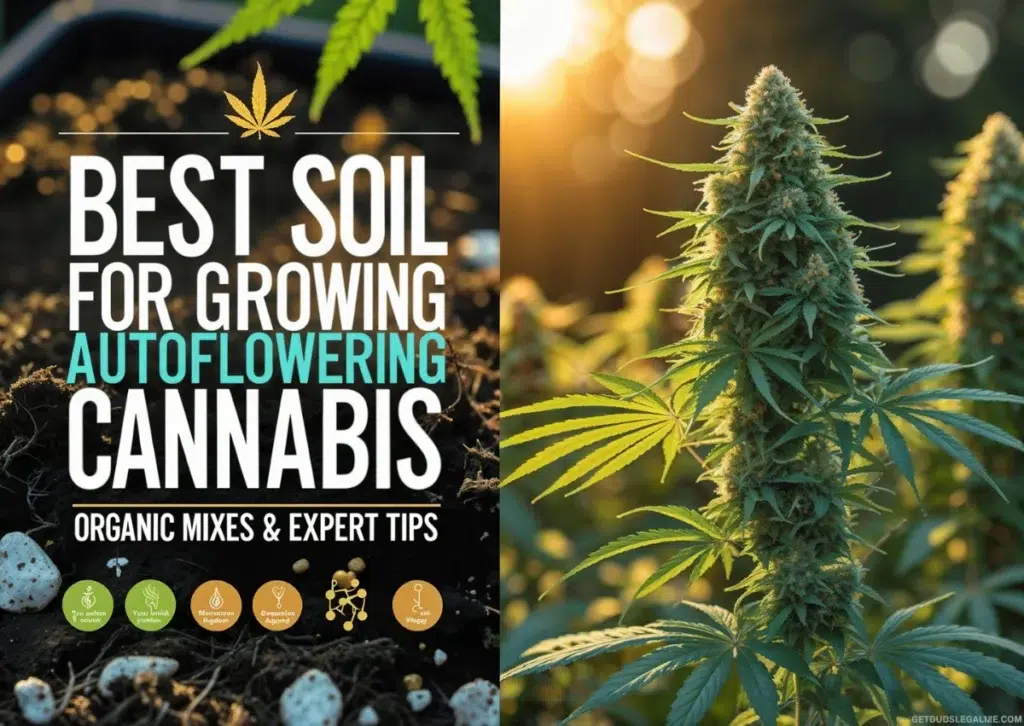How to Grow a Cannabis Bonsai Tree: A Complete Guide for Beginners
If you’ve ever dreamed of cultivating a miniature cannabis plant that’s as beautiful as it is potent, a cannabis bonsai tree might be the perfect project for you. This unique endeavor combines the timeless artistry of bonsai with the functionality of cannabis cultivation, allowing you to create a miniature masterpiece that serves both as a decorative item and a source of high-quality buds.
In this complete guide, we’ll walk you through each step of the process—whether you’re just starting out or you’re an experienced grower—helping you to create a cannabis bonsai tree from seed to harvest.
What is Bonsai?
Bonsai is a centuries-old Japanese art form that involves growing miniature trees, mimicking the shape and beauty of full-sized trees. Through various techniques like pruning, shaping, and root restriction, bonsai artists create aesthetically pleasing trees that, despite their small size, resemble their larger counterparts in form and grace.
Traditional bonsai usually involves non-cannabis species, but cannabis bonsai is a modern twist, blending the ancient practice with the versatility of cannabis.
With the right skills, you can apply these same techniques to a cannabis plant, producing something both visually striking and functional.
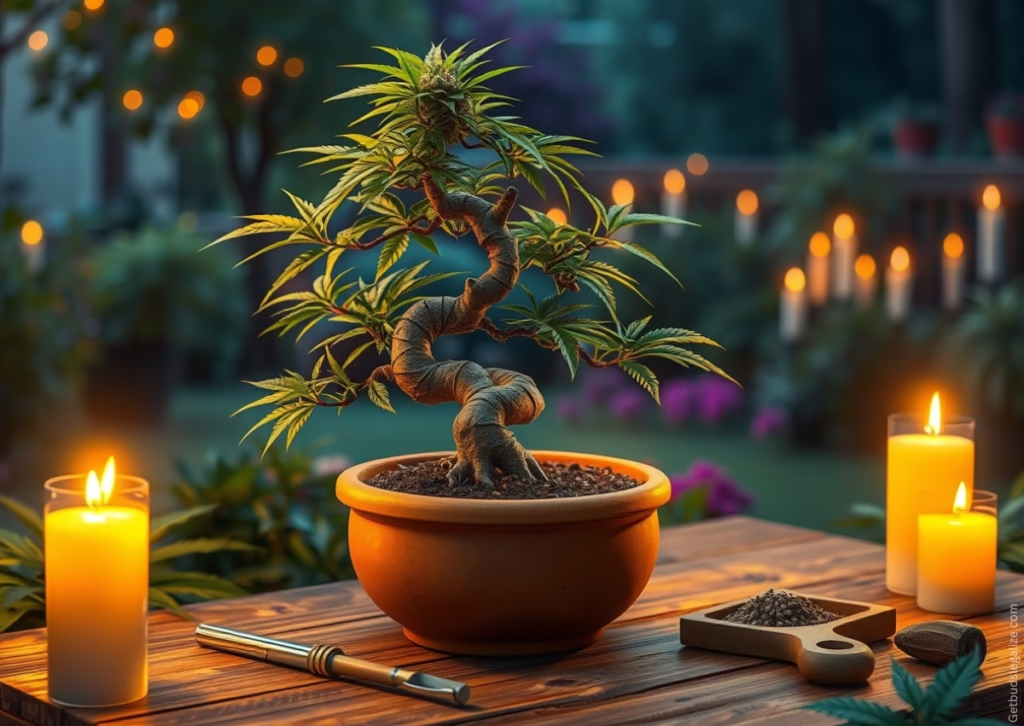
Why Cannabis Makes a Great Bonsai Plant
Cannabis is an incredibly adaptable plant, making it an ideal candidate for bonsai cultivation. Its flexible growth habits, especially in certain strains, make it easier to manipulate through bending, pruning, and tying—essential techniques in bonsai artistry.
Additionally, canna bonsai trees offer dual benefits: they provide a stunning aesthetic and allow you to grow potent buds for medicinal or recreational use.
With careful training and attention, you can create a compact, beautiful cannabis bonsai tree that thrives in small spaces, making it perfect for indoor growers or those who wish to combine artistry with cultivation.
Step-by-Step Guide to Growing Your Cannabis Bonsai Plant
Step 1: Choose the Right Pot
The first step is selecting a small, shallow container. This is crucial because the pot needs to restrict the growth of the roots, promoting horizontal growth instead of vertical. A shallow pot limits the space available for root development, forcing the plant to stay compact and bushy.
Pot Size Matters
- Size: Opt for a pot that’s large enough to accommodate your plant’s root system but small enough to control its height. A larger pot may encourage root expansion, resulting in a taller, less compact plant.
- Drainage: Ensure the pot has adequate drainage holes to prevent water buildup, which could lead to root rot.
- Material: Consider using a pot made of porous material like terracotta or a fabric pot, which helps with root aeration and prevents waterlogging.
Step 2: Select the Right Cannabis Strain
Choosing the right cannabis strain is key to your cannabis bonsai’s success. Look for compact, short-growing strains that are easier to manage and manipulate. Autoflowering and Indica-dominant strains are typically the best choices, as they naturally stay smaller and are more manageable for bonsai cultivation.
Top Strains for Cannabis Bonsai:
- Northern Lights Auto: A robust autoflowering strain known for its resilience and compact nature, perfect for beginners.
- Strawberry Pie Auto: A compact, fruity autoflower strain that stays small and produces great yields.
- Lowryder: A classic autoflower strain that is extremely small and fast-growing, ideal for bonsai enthusiasts.
- White Widow: A balanced hybrid with a compact growth habit, suitable for both beginners and experienced growers.
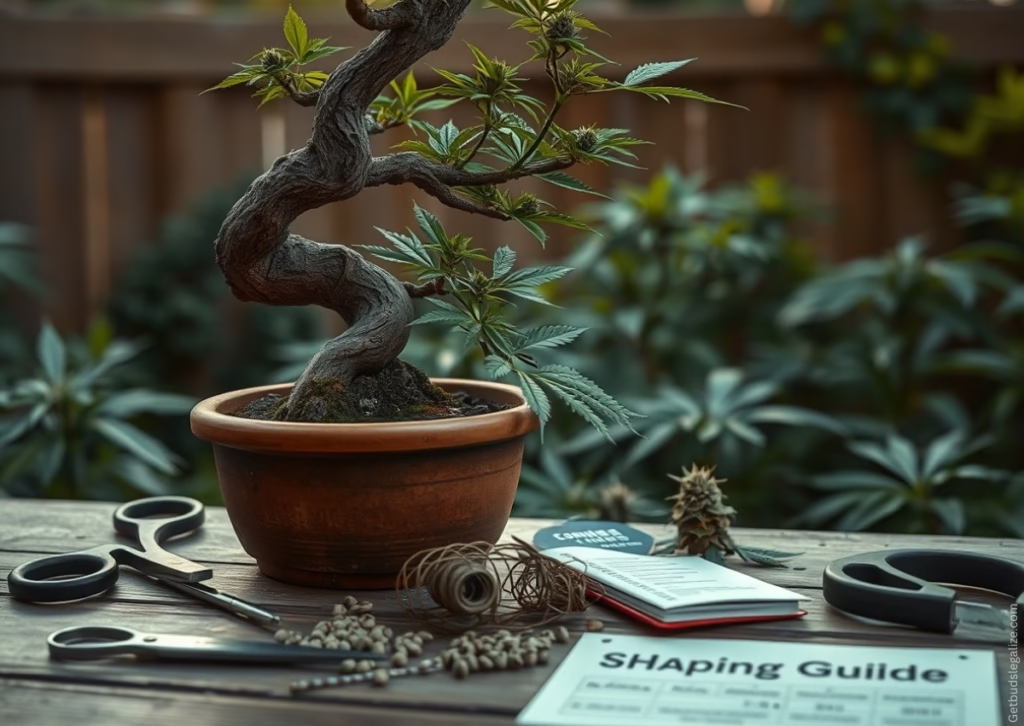
Step 3: Germinate Your Seeds
Germination is the first step in bringing your cannabis bonsai to life. Cannabis seeds can be germinated using a damp paper towel or directly in your growing medium (soil or hydroponics). To promote germination, keep the seeds in a warm, dark environment.
Once the seed has sprouted, gently transplant it into your chosen pot. Be careful with the delicate roots to minimize transplant shock.
Step 4: Train Your Plant with Low-Stress Training (LST)
Low-stress training (LST) is the key technique for shaping your cannabis bonsai. This method encourages horizontal growth by bending and tying down the main stem and branches, creating a bushier appearance.
Start bending the branches once your plant has developed 3–4 weeks of growth. Use soft plant ties or wire to gently secure the branches in place. LST promotes lateral growth, which is essential for achieving the bonsai look.
💡 Pro Tip: Be careful not to over-tighten the ties as this can restrict airflow and harm the plant.
Step 5: High-Stress Training (HST) – Optional
For those looking to accelerate the process, High-Stress Training (HST) techniques such as topping or fimming can be effective. Topping involves cutting off the top of the plant to promote growth at lower nodes while fimming partially cuts the top to encourage multiple new shoots.
Although these techniques can speed up bushy growth, they can also stress the plant, so use them sparingly.
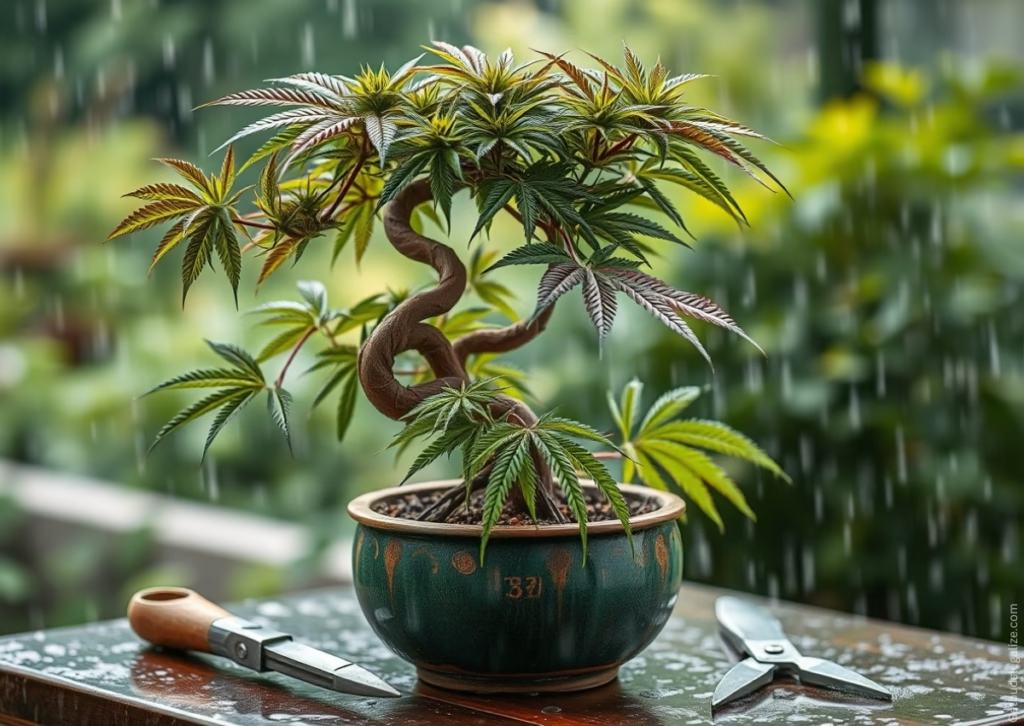
Step 6: Pruning and Shaping Your Cannabis Bonsai
Pruning is essential for maintaining the compact, symmetrical shape of your cannabis bonsai tree. Remove excess growth from the center of the plant to allow more light to reach the lower branches, and trim any stray or overly long branches. Regular pruning will help you maintain the classic bonsai form.
💡 Common Mistake to Avoid: Avoid excessive pruning early on, as it can stunt growth. Start with small, gentle trims and monitor your plant’s response.
Step 7: Watering and Nutrient Care
Watering is essential but should be done carefully. Too much water can cause root rot, while insufficient watering can slow growth. The soil should stay moist, not waterlogged.
Use a cannabis-specific nutrient solution to deliver the necessary nutrients, and regularly check the pH level of the soil to ensure proper nutrient uptake. As your plant grows, adjust the feeding schedule to match its development.
Step 8: Harvesting Your Cannabis Bonsai
Despite its small size, your cannabis bonsai can still produce potent buds. The best time to harvest is when the trichomes (resin glands) turn from clear to milky white with a hint of amber.
To harvest, carefully use clean scissors or pruning shears to cut the branches. After harvesting, cure the buds properly to preserve their potency and flavor.
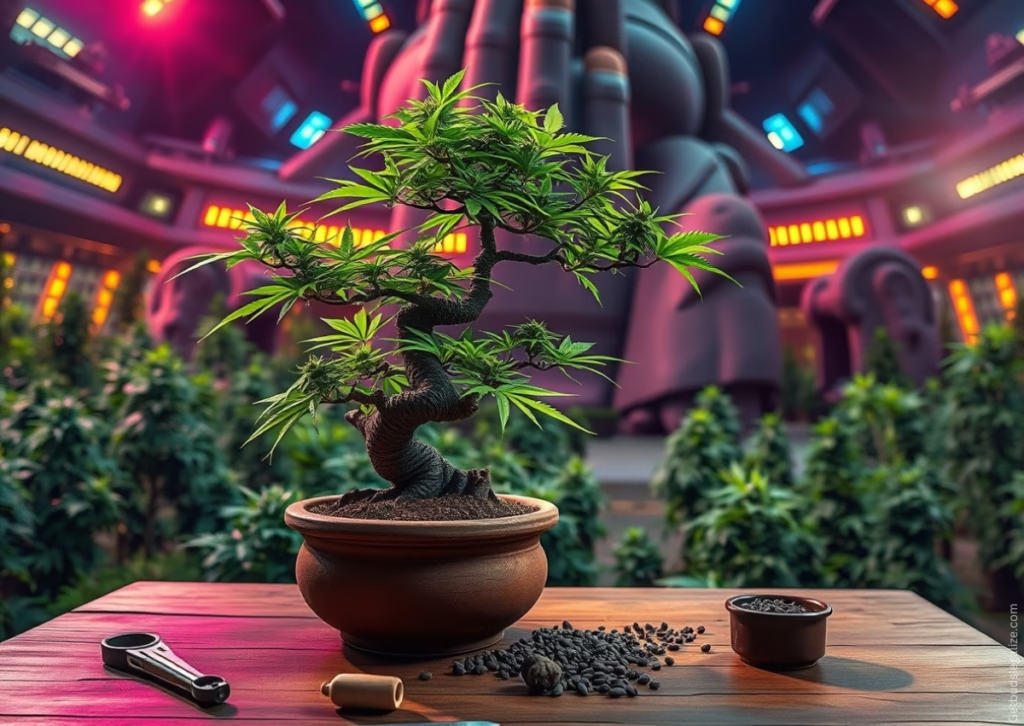
Tips for Maintaining Your Cannabis Bonsai
Maintaining your cannabis bonsai requires attention to detail and a solid understanding of your plant’s needs. Here are some key tips for keeping your bonsai healthy and thriving:
- Lighting: During the vegetative stage, keep the plant under 18 hours of light per day. Switch to 12 hours once the plant enters the flowering phase.
- Temperature: Maintain temperatures between 65-80°F (18-27°C) for optimal growth.
- Humidity: Ideal humidity levels are between 40-50%. A humidifier can help regulate these levels.
- Fertilizing: Regular fertilization is key. Use a high-quality fertilizer designed for cannabis and follow the instructions carefully to avoid nutrient imbalances.
Common Mistakes to Avoid When Growing Cannabis Bonsai
While growing canna bonsai is an incredibly rewarding process, there are a few common mistakes that can hinder your plant’s growth or compromise its beauty. By avoiding these pitfalls, you can ensure your bonsai thrives:
- Overtraining: Excessive training can stunt your plant’s growth. Allow the plant to recover fully between training sessions.
- Choosing the Wrong Pot Size: A larger pot encourages unwanted root growth. Stick to smaller pots to maintain a compact plant.
- Overwatering: Cannabis bonsai trees thrive in slightly dry conditions. Avoid overwatering to prevent root rot or mold.
Conclusion: Enjoy Your Cannabis Bonsai Journey
Growing a cannabis bonsai tree is a rewarding and creative process. Whether you’re a beginner or an experienced grower, this project will teach you patience and precision. With the right strain, techniques, and care, you can craft a miniature cannabis tree that’s as functional as it is stunning.
💡 Pro Tip: If you’re just starting, choose a low-maintenance strain and focus on mastering the basics. As you gain confidence, experiment with more advanced shaping techniques to create intricate and unique cannabis bonsai trees.
Frequently Asked Questions (FAQ) about How to Grow Weed Bonsai
A cannabis bonsai tree is a miniature version of a cannabis plant that is carefully shaped and maintained using bonsai techniques like pruning, tying, and restricting root growth.
Unlike regular cannabis plants, which grow tall and wide, canna bonsai trees remain compact and small in size while still producing high-quality buds. The art of bonsai cultivation allows you to grow a visually striking cannabis plant that thrives in small spaces.
Compact, Indica-dominant and autoflowering strains are generally the best choices for canna bonsai due to their smaller size and quicker growth cycles. However, hybrid strains and certain sativa-dominant varieties can also be suitable, depending on your available space and cultivation goals.
Experimenting with different strains allows you to explore unique characteristics, creating a more personalized cannabis bonsai experience that suits your preferences.
It usually takes 3 to 6 months to grow a canna bonsai tree, depending on the strain and the techniques you use. Autoflowering strains typically mature faster, while regular cannabis strains may take longer to reach the desired bonsai shape and produce buds.
While indoor cultivation is more common for cannabis bonsai due to better environmental control, outdoor cultivation is also possible in suitable climates.
Be aware that outdoor conditions may cause your plant to grow larger than expected, requiring adjustments to your training techniques to maintain its compact size.
For optimal growth, use full-spectrum LED lights that provide the appropriate wavelengths for both vegetative growth and flowering. Maintain an 18-hour light cycle during the vegetative stage, then switch to a 12-hour light cycle during flowering to simulate natural light patterns and promote bud production.
For cannabis bonsai, it’s essential to use a well-draining, slightly acidic soil mix with a pH between 6.0 and 7.0. A mix of peat moss, perlite, and vermiculite works well, ensuring good aeration and drainage. Adding organic compost helps provide the nutrients necessary for healthy growth.
Water your marijuana plant every 2-3 days, but always check the soil moisture first. Overwatering can lead to root rot, so allow the top 1-2 inches of soil to dry out before watering again. Cannabis bonsai plants prefer slightly dry conditions between waterings, making it crucial to avoid soggy soil.
The best way to determine when your cannabis bonsai is ready for harvest is by inspecting the trichomes. When the trichomes turn from clear to milky white with some amber-colored trichomes, your plant has reached peak potency and is ready for harvest. You can use a magnifying glass or jeweler’s loupe to closely examine the trichomes for the perfect harvest window.
To prevent pests and diseases in your cannabis bonsai, regularly inspect the plant for issues such as aphids, spider mites, or mold. Organic methods like neem oil or insecticidal soap can help control infestations.
Additionally, ensure good air circulation around your plant and avoid excessive humidity to prevent mold and mildew growth.
It is generally not recommended to reuse soil for growing cannabis, as it may lose nutrients and harbor pathogens. If you do reuse soil, you should amend it with fresh compost, organic matter, and fertilizers to replenish its nutrient content and ensure your cannabis bonsai gets the proper nutrients for healthy growth.
Yes, cannabis bonsai trees thrive indoors when provided with proper lighting, ventilation, and temperature control. Indoor environments offer the advantage of year-round cultivation, allowing growers to carefully monitor and adjust the conditions to ensure optimal growth.
With the right setup, cannabis bonsai plants can flourish in a compact, controlled space.
Choosing the right pot is essential when growing canna bonsai. Small, breathable pots, such as fabric containers, are ideal because they provide better aeration, prevent waterlogging, and support healthy root growth.
Make sure the pot has proper drainage to avoid excess moisture that could damage the roots. The right pot is crucial for maintaining your plant’s compact size and overall health.
The frequency of pruning depends on how quickly your cannabis bonsai is growing. Pruning every 2-4 weeks is typically recommended to maintain its desired shape and size. Focus on removing excess branches and dead leaves while improving airflow around the central stem.
Regular pruning helps preserve the classic bonsai aesthetic while promoting healthy growth and optimal bud production.
Yes, there are several alternative methods for shaping canna bonsai branches. Techniques like low-stress training (LST) or the use of plant ties provide flexibility in guiding branch growth.
These approaches apply gentle pressure to the plant, allowing you to shape it without causing stress, and helping you achieve the desired bonsai form. Experiment with different methods to find the best technique for your bonsai.
To grow a cannabis bonsai tree indoors, you’ll need a small cannabis grow setup designed for compact spaces. Follow these steps:
- Use a breathable pot with good drainage, such as a fabric container.
- Choose compact strains like autoflowering or Indica-dominant varieties for easier management.
- Install full-spectrum LED lights for proper lighting, maintaining 18-hour light cycles for vegetative growth and 12-hour cycles for flowering.
- Maintain consistent temperature (70-85°F) and humidity (40-60%) levels.
- Regularly prune and train branches using twine or plant ties to achieve the desired bonsai shape.
With this setup, you can grow cannabis in a visually stunning bonsai form while optimizing your indoor space.
A good starter kit should include the following items:
- Small pots or containers: Fabric pots or pots with proper drainage to encourage healthy root growth.
- Soil mix: A well-draining, slightly acidic mix suitable for cannabis plants.
- Pruning tools: Small scissors or shears for shaping the plant and maintaining its bonsai form.
- Training accessories: Twine, plant ties, or low-stress training (LST) equipment to guide the plant’s growth.
- Nutrients: Organic or cannabis-specific fertilizers to support healthy growth and bud production.
- Grow lights: For indoor cultivation, full-spectrum LED grow lights may be included or recommended.
ILGM Fertilizer

Ultimate Marijuana Fertilizer
Nourish your plants from seedling to harvest with our premium formula!
- Enough for 5+ Plants: Perfect for your growing needs.
- Exclusive Discount Package: Save more while you grow!
- Versatile Use: Ideal for soil, hydroponics, and all growing mediums.
- Optimal Plant Health: The best way to ensure robust growth and thriving yields.
ILGM Plant Protector

Ultimate Plant Protection for Your Cannabis
Safeguard your plants from diseases and harmful pests with our effective formula!
- Comprehensive Protection: Keep your cannabis healthy and thriving.
- Three 20 ml Bottles: Sufficient supply for up to 20 plants.
- Versatile Application: Perfect for soil, hydroponics, and all growing mediums.
- Peace of Mind: Ensure a healthy garden with our trusted protector.














